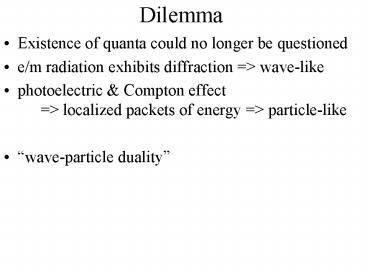Dilemma - PowerPoint PPT Presentation
Title: Dilemma
1
Dilemma
- Existence of quanta could no longer be questioned
- e/m radiation exhibits diffraction gt wave-like
- photoelectric Compton effect gt localized
packets of energy gt particle-like - wave-particle duality
2
Wave properties
Photon detector clicks when a photon is absorbed
3
Probability Waves
- Photon detector might be a photoelectric device
- at any point, the clicks will be randomly spaced
in time - cannot predict when a photon will be detected at
any point on the screen - if we move the detector, the click rate increases
near an intensity maximum - the relative probability that a single photon is
detected at a particular point in a specified
time ? Intensity at that point - intensity ? Em2 Probability of detection
? Em2
4
Probability Wave
- Probability (per unit time) that a photon is
detected in some small volume is proportional to
the square of the amplitude of the waves
electric field in that region - Postulate that light travels not as a stream of
photons but as a probability wave - photons only manifest themselves when light
interacts with matter - photons originate in the source that produces the
light wave (interaction) - photons vanish on the screen (interaction)
5
Single-photon version (1909)
- Light source is so weak that it emits only one
photon at a time at random intervals - interference fringes still build up
- raises the question if the photons move through
the apparatus one at a time, through which slit
does the photon pass? - How does a given photon know that there is
another slit? - Can a single photon pass through both slits and
interfere with itself?
6
Electrons and Matter Waves
- Light is a wave but can transfer energy and
momentum to matter in photon sized lumps - can a particle have the same properties?
- can it behave as a wave?
- a matter wave
- de Broglie (1924) suggested ?h/p
- de Broglie
wavelength - a beam of electrons has a wavelength and should
diffract if slit width comparable to ?h/p - 1927 Davisson and Germer observed diffraction of
electrons from crystals
7
Diffraction
- Recall for a single slit, the diffraction minima
are at a sin? m? - if ? ltlta, then all ?m?/a are small and the
light essentially travels as a ray and does not
spread out - need ? ? a for strong diffraction effects
- eg. 1 kg billiard ball moving at 5.0 m/s
- ?h/p h/mv (6.63x10-34 J.s)/(1kg)(5.0m/s)
1.3 x 10-34 m ltlt size of atoms - gt no diffraction
8
Diffraction
- eg. Electrons with kinetic energy of 54.0 eV
- if Kp2/2me , then p(2meK)1/2
(2 x 9.11x10-31 kg x 54eV x 1.6x10-19
J/eV)1/2 3.97 x 10-24 kg. m/s - ?h/p (6.63x10-34 J.s)/(3.97x10-24 kg.m/s)
1.67 x 10-10 m .167 nm - smaller mass gt larger ?
- typical atom has diameter of 10-10 m
9
Diffraction
- regular arrays of atoms (crystals) should
diffract electrons! - Neutrons can also diffract gt study structures of
solids and liquids
10
Double Slit Experiment with electrons (1989)
11
(No Transcript)
12
X-ray beam (light wave)
Electron beam (matter wave)
13
Problem
- Singly charged Na ions are accelerated through a
potential difference of 300 V. What is (a) the
momentum acquired? (b) what is the de Broglie
wavelength? - Solution K qV (1.6x10-19 C)(300V)
4.80 x10-17 J 300 eV - m(22.9898 g/mole)/(6.02x1023 atom/mole)
3.819 x10-23 g 3.819 x 10-26 kg
14
Solution
- (a) p (2mK)1/2 2(3.819x10-26)(4.8x10-17)1/2
1.91 x10-21 kg.m/s - (b) ? h/p (6.63x10-34 J.s)/(1.91x10-21
kg.m/s) 3.46 x10 -13 m
15
What is Waving?
- If particles behave as waves, what is waving?
- Wave on a string gt particles in string execute
SHM - sound wave in air gt air molecules oscillate in
SHM - light wave gt electric and magnetic fields
oscillate - e.g. E(x,y,z,t) electric field varies from
place to place and with time - intensity ? E2
- what varies from place to place for a matter
wave? - Wave function ?(x,y,z,t) psi
16
Schrödinger Equation
- Schrödinger Equation 1926 H?E?
- ?(x,t) is a solution of this equation
- the wave equation for matter waves
- probability waves
- probability density is P(x,t) ?(x,t)
?(x,t) ?(x,t)2
17
A harmonic wave has a definite value of k but
extends to infinity
A wave packet has a spread of k- values but is
localized
?k.?x ? 1
??.?t ? 1
18
Example
- Radar transmitter emits pulses of electromagnetic
radiation which last 0.15 ?s at a wavelength of ?
1.2 cm - (a) to what central frequency should the radar
receiver be set? - (b) what is the length of the wave packet?
- (c ) how much bandwidth should the receiver have?
- (a) f0 c/?0 3 x 108 m/s /1.2 x 10-2 m 26
GHz - (b) ?x c?t (3 x 108 m/s)(.15 x 10-6 s) 45 m
- (c ) ?f ??/2? 1/(2??t) 1/(6.28 x .15 x 10-6
s) 1.1 MHz

